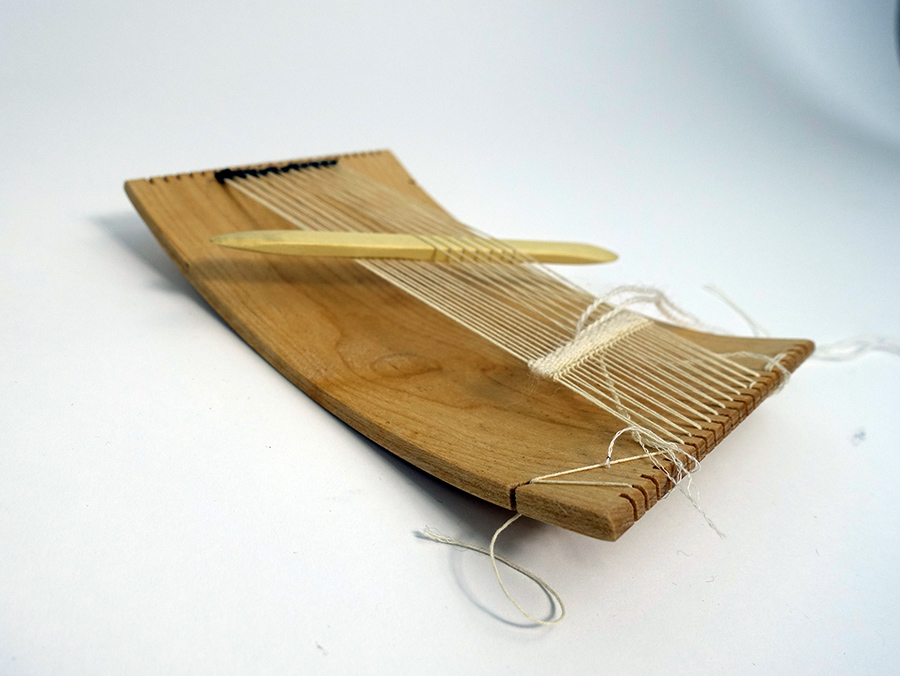I have been teaching workshops in a variety of places recently, to guilds, conferences, and smaller shops. Each has their own challenge in terms of looms. I frequently get questions when posting photos of student looms on my blog. People want to know what others are using and why. Here are my feeling about tapestry looms for workshops. Keep in mind, these are just my opinions and you undoubtedly have your own reasons for what you use... as does every tapestry teacher out there. When I am in my own studio, I weave tapestry on a Harrisville rug loom. Most of us have a small loom we use for carting about and those are the looms I want to talk about.
A tapestry loom has to hold a high tension. A loom you are working on in a workshop is no exception. If you start with a poor tool, you won't be encouraged by your results and won't want to continue working in tapestry. Using a good loom to learn on is important. Tension is one of the biggest issues.
Rigid heddle looms: My issue with most rigid heddle looms is that, in my experience, most of them do not hold a good tension. The shedding device (the rigid heddle) works fine for weaving tapestry, but the tensioning mechanism is usually poor. Many of these looms have a "beam" on each side which just doesn't tighten enough. That said, I have had a couple
rigid heddle looms in my classes that worked far better than I expected
them to.
Table Looms: I used to have a LeClerc Dorothy loom which my grandmother gave me. It
was meant for weaving fabric and actually had 8 harnesses. The beams
were tiny though and I couldn't ever get it tight enough for tapestry. I have found that most table looms have this problem. I have seen looms that do work fairly well for tapestry in this category. In the Michigan (
Michigan League of Handweaver's Conference) class I taught this summer, one of the students
makes looms with her husband and their table loom was not only
beautiful, it worked quite well for tapestry. You can see Bruce and Ann
Niemi's looms at
www.kessenichlooms.com.
A loom that a blog-reader recently asked me about was the
LeClerc Penelope II. This link is to a vendor's website.
LeClerc has a website but it is exceedingly clumsy (so go to that link at your own risk--you have to download PDFs to see what they sell, though LeClerc does make excellent looms). I have never seen one of these looms in person, but from this photo and the description, I feel that this is basically a table loom tipped upright for weaving tapestry. If you've tried it, let me know!
Archie Brennan pipe looms: These looms show up at almost every workshop and if you want to make your own loom, I recommend the design. Archie has offered the design for these looms for a long time. Here is a link to a place you can order one disassembled or get diagrams for making one.
Archie Brennan pipe loom diagrams.
These looms are made of copper pipe and use threaded rods for a tension device. People use various methods for standing them including
Tommye's solution here. I have seen people use inexpensive painters easels also to hold the loom. Of course some people just lay them on their lap and against a table (perhaps not the best ergonomic solution however).
Another tapestry weaving friend of mine,
Jane Hoffman, makes her own copper pipe looms and has made her own shedding device so she doesn't have to use leashes or pick a shed.
The loom below is one that a student brought to the last workshop I taught. The loom is not labeled. Does anyone know what it is or who makes it? It had a beam system for tensioning, though the teeth on the beams were large and I didn't feel like it got a tight enough tension. It used leashes for shedding. The advantage of a loom like this is that you can put on a long continuous warp.
I don't work for
Mirrix, but for my money, it has become the best
tapestry loom out there that you buy ready to weave on. These looms are
pretty much bomb-proof, super sturdy, infinitely tightenable (if you
don't loose that little wrench they send with it--seriously, keep track
of that!), and come in a wide variety of sizes. I believe Elena and
Claudia originally designed this loom for beading, but it quickly became
apparent that tapestry weavers were going to love it. The shedding
mechanism is easy to install and works smoothly. You can put on a warp
that wraps around the loom and rotate it for more length. It uses a
spring at the top (and now at the bottom if you choose) to space the
warp evenly (yes, you need to take the spring at the bottom out after
you have woven a few inches so that you can advance your work).
 |
| This is the tightening tool for a Mirrix loom. It is extremely handy and you should not lose it... though I'm sure you could buy another if you did. |
I recently read this
blog post by Janette Meetze about a recent tapetsry workshop she taught. I looked at her photos and realized everyone in her class was using a Mirrix. I emailed her and turns out she has a stash of them that she uses for teaching. It is an interesting idea to have a set of little looms for teaching beginners. Of course my current house/studio combination being quite small, I think my partner might have my head if I decided to invest in a fleet of new looms. Perhaps one day though.
What workshop loom do you like to use?









